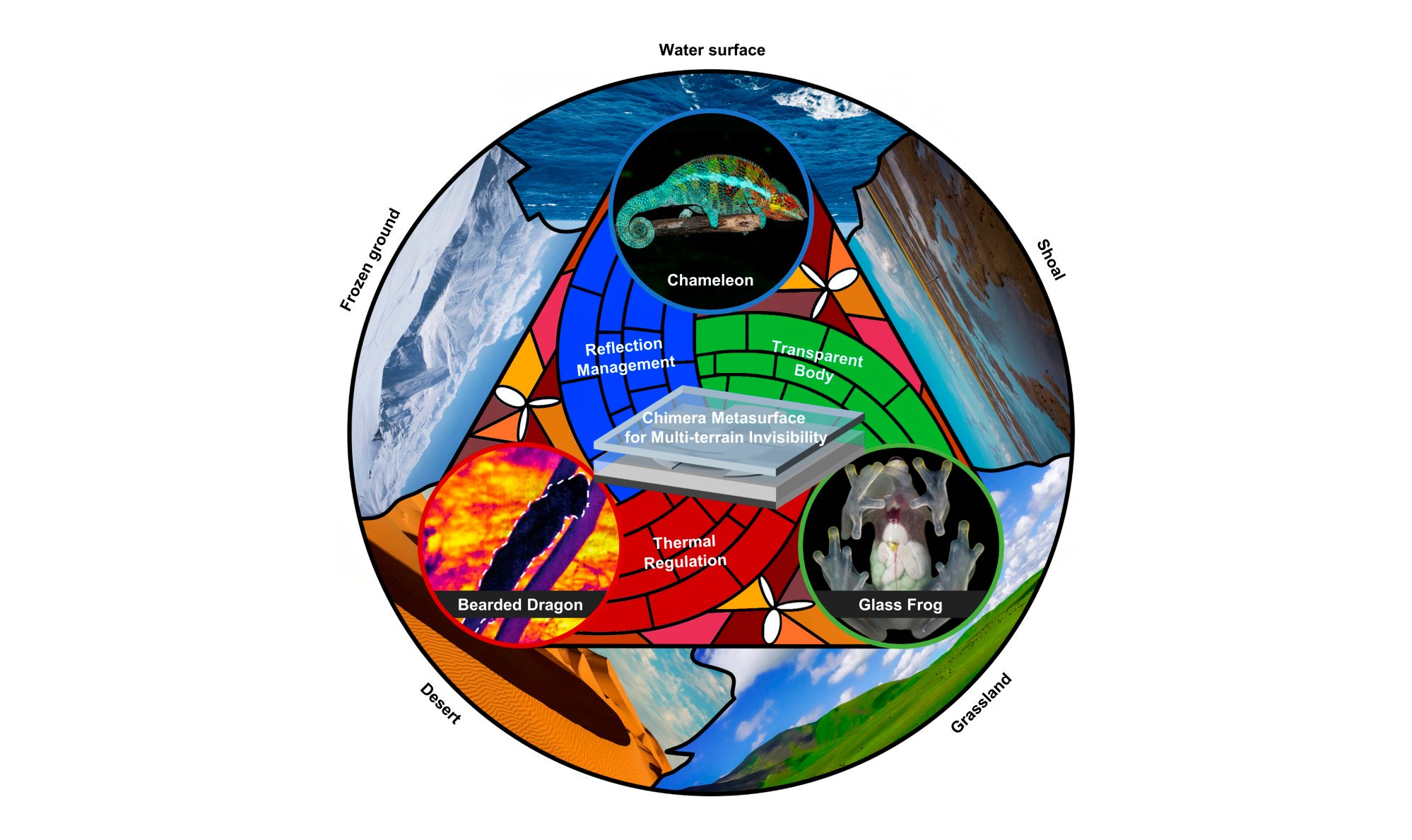Chinese scientists have claimed to have achieved a remarkable fusion of myth and science by unveiling a groundbreaking hybrid material purported to bring the invisibility cloak concept to life.
Drawing inspiration from the mythical Chimera and the unique attributes of three cold-blooded creatures—the chameleon, glass frog, and bearded dragon—the researchers have made significant strides in material innovation, according to claims in Chinese media.
This material, named Chimera metamaterial, holds the potential to transform both military stealth technology and wildlife conservation efforts.
The Hong-Kong-based SCMP first reported on the development of the Chimera metamaterial, which aims to overcome the limitations of existing camouflage technologies by adapting to various terrains and spectral conditions.
The scientists have designed an experimental version based on each animal’s distinct natural survival strategy. This version could be undetectable across microwave, visible light, and infrared spectra, according to the report.

The research team’s bionics-inspired approach marks a major stride in metamaterial applications. It leverages the electromagnetic wave manipulation capabilities of these synthetic constructs. This renders objects undetectable to radar.
“Our work transitions camouflage technologies from the constrained scenario to ever-changing terrains and constitutes a big advance towards new-generation reconfigurable electromagnetics [that can] change circuit topologies,” they said.
As stated, Metamaterials, through manipulation of their surface structures, acquire the capacity to intricately reflect electromagnetic waves, thus proficiently cloaking objects from radar detection.
However, their predetermined functionalities limit their effectiveness in diverse environmental settings.
Chinese scientists conceived a metamaterial with the versatility to adjust to diverse spectral conditions and terrains. Remarkably, this metamaterial maintains its capability to elude detection from both visible and infrared light sources.
Chimera’s innovation presents promising prospects for military utilization, offering strategic advantages. By facilitating seamless blending into diverse environments, Chimera enables objects or personnel to evade detection by radars, infrared detectors, and optical devices.
This capability could enhance military operations and maintain a tactical edge in various scenarios.
Even amid the ongoing Russia-Ukraine conflict, both sides have asserted notable progress in developing camouflage suits to counter the thermal imaging equipment used by their adversaries.
On January 24, HiderX, a Russian company, announced the development of a new camouflage suit designed to manipulate the ambient temperature surrounding the wearer. This innovation aims to render Russian servicemen practically invisible to thermal imaging devices employed by enemy forces.
Similarly, Ukraine made comparable claims last year regarding the creation of an “invisibility cloak” to protect Ukrainian soldiers from Russian thermal imaging technology.
Mimicking Nature’s Versatility
Central to China’s innovation is the concept of adaptability, with the envisioned metamaterial, dubbed “Chimera” in homage to the mythical creature, poised to seamlessly blend into various spectral conditions and landscapes while thwarting visible and infrared surveillance.
The researchers highlighted the remarkable versatility of the Chimera metasurface, which is capable of harmonizing with five distinct terrains across the frequency spectrum.
The metamaterial’s genesis lies in the chameleon’s famed ability to alter skin pigmentation, mirrored in the Chimera’s capacity to modulate microwave reflections to match different environmental backdrops.
The report added that the inspiration from the glass frog’s natural transparency during slumber led to the incorporation of similar optical traits, achieved through strategic placement of circuitry within layers of PET plastic and quartz glass.
Addressing the challenge of thermal concealment, akin to the bearded dragon’s thermoregulatory prowess, the researchers devised a mechanism to minimize temperature differentials, which rendered the Chimera virtually invisible to infrared detection methods.

Through meticulous development stages involving patterned plastic substrates, metal mesh formations, and precise assembly techniques, an experimental iteration of the Chimera metamaterial demonstrated its multifaceted stealth capabilities.
The potential applications of this technology are vast and varied, spanning from military operations, where it could provide significant strategic advantages, to wildlife conservation, where it could facilitate non-invasive observation of animals in their natural habitats.
The SCMP report suggests that by mitigating human interference in ecosystems, Chimera stands poised to bolster conservation initiatives and offer a glimpse into a future where the boundaries between science and nature blur in pursuit of mutual symbiosis.
Nonetheless, military forces continuously push innovation boundaries in cutting-edge camouflage technologies.
Countries like the US and Israel are also engaged in research and development to create diverse invisibility cloaks capable of concealing soldiers, vehicles, tanks, and aircraft from various identification methods.
Despite these advancements, a flawless design that can render troops completely invisible in battle has yet to emerge.
- Contact the author at ashishmichel(at)gmail.com
- Follow EurAsian Times on Google News




